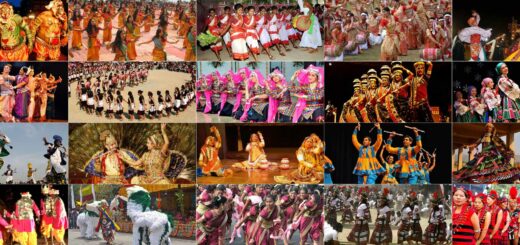Art & Culture: Theatre Forms of India
by
Mentors4ias
·
May 18, 2019
Traditional Theatre
- Living traditions occupy a prominent place in the Indian social system. Any living tradition has a natural flow. There can be no doubt about the fact that traditional art forms reflect the ideals of the society, its determination to survive, its ethos, emotions, fellow-feelings, and so on. Drama in itself is a complete form of arts. It includes in its framework acting, dialogue, poetry, music, etc.
- In community living, the art of singing has its own importance. In all the traditional theatre-forms, songs and the art of singing have an important role to play. Traditional music of the theatre is an expression of the feelings of the community.
- Traditional theatre forms incorporate not only the common man’s interests but there is also a classical element in them. This classical facet, however, takes on regional, local and folk coloring.
- In traditional theatre forms there are special styles of dance portraying the entry on to the stage or platform, narrative and descriptive roles.
- The best example of descriptive acting is the Bidapat naach. In this traditional theatre form, emphasis is not on beauty but on acting itself and narrative and descriptive skills.
- Dance as a narrative art is the base of theatre form which can be seen in the traditional theatre form of Bhavai of Gujarat. In this form, quick or slow foot movement is a means of narration. The art of making the entry by dancing has been perfected in the traditional Kashmiri theatre form, Bhand Jashn.
- The way each character walks and enters the platform, identifies him. In Koodiyaattam and Ankia Naat, the entry by dancing itself is complicated and artistic. In the forms, the tempo and basic posture and gesture identifies the role of the character.
- Traditional theatre forms have a common distinguishing feature that is the element of simplicity. What is the underlying force of traditional theatre forms that has enabled it to survive and maintain its simplicity? The fact remains, that it is the immediate, direct, realistic and rhythmic relationship that the spectators are able to develop with the artists of traditional theatre forms which is generally not experienced in other art forms. It is reflected in the applaud by the spectators by means of clapping their hands.
- The development of traditional theatre forms is based on such local and regional peculiarities which are not bound and restricted by social and economic divisions, limitations, etc. Tradional art forms have influenced classical art forms and vice-versa. It is an eternal journey in the sphere of ‘culture’.
Different Forms Of Traditional Theatre
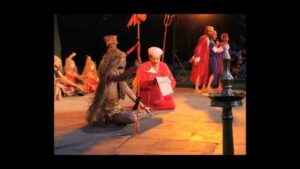
- Bhand Pather: the traditional theatre form of Kashmir, is a unique combination of dance, music and acting. Satire, wit and parody are preferred for inducing laughter. In this theatre form, music is provided with surnai, nagaara and dhol. Since the actors of Bhand Pather are mainly from the farming community, the impact of their way of living, ideals and sensitivity is discernible.
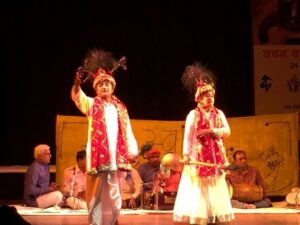
- Swang: Originally the theatre form Swang, was mainly music-based. Gradually, prose too, played its role in the dialogues. The softness of emotions, accomplishment of rasa alongwith the development of character can be seen in this theatre form. The two important styles of Swang are from Rohtak and Haathras. In the style belonging to Rohtak, the language used is Haryanvi (Bangru) and in Haathras, it is Brajbhasha.
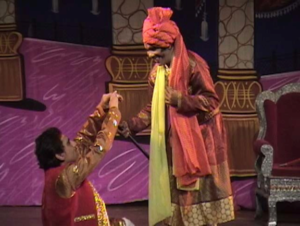
- Nautanki: is usually associated with Uttar Pradesh. The most popular centres of this traditional theatre form are Kanpur, Lucknow and Haathras. The meters used in the verses are: Doha, Chaubola, Chhappai, Behar-e-tabeel. There was a time when only men acted in Nautanki but nowadays, women have also started taking part in the performances. Among those remembered with reverence is Gulab Bai of Kanpur. She gave a new dimension to this old theatre form.
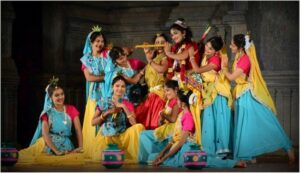
- Raasleela: is based exclusively on Lord Krishna legends; it is believed that Nand Das wrote the initial plays based on the life of Krishna. In this theatre form the dialogues in prose combined beautifully with songs and scenes from Krishna’s prank.
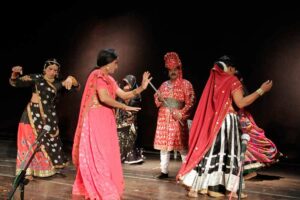
- Bhavai :is the traditional theatre form of Gujarat. The centers of this form are Kutch and Kathiawar. The instruments used in Bhavai are: bhungal, tabla, flute, pakhaawaj, rabaab, sarangi, manjeera, etc. In Bhavai, there is a rare synthesis of devotional and romantic sentiments.

- Jatra: Fairs in honour of gods, or religious rituals and ceremonies have within their framework musical plays are known as Jatra. This form was born and nurtured in Krishna Jatra became popular due to Chaitanya’s influence. Later, however, worldly love stories too, found a place in Jatra. The earlier form of Jatra has been musical. Dialogues were added at later stage. The actors themselves describe the change of scene, the place of action, etc.
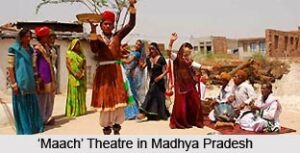
- Maach: is the traditional theatre form of Madhya Pradesh. The term Maach is used for the stage itself as also for the play. In this theatre form songs are given prominence in between the dialogues. The term for dialogue in this form is bol and rhyme in narration is termed vanag. The tunes of this theatre form are known as rangat.
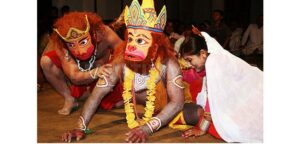
- Bhaona: is a presentation of the Ankia Naat of Assam. In Bhaona cultural glimpses of Assam, Bengal Orissa, Mathura and Brindavan can be seen. The Sutradhaar, or narrator begins the story, first in Sanskrit and then in either Brajboli or Assamese.
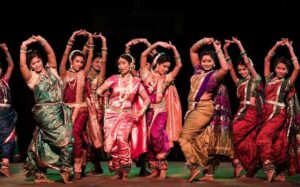
- Tamaasha: is a traditional folk theatre form of Maharashtra. It has evolved from the folk forms such as Gondhal, Jagran and Kirtan. Unlike other theatre forms, in Tamaasha the female actress is the chief exponent of dance movements in the play. She is known as Murki. Classical music, footwork at lightning-speed, and vivid gestures make it possible to portray all the emotions through dance.
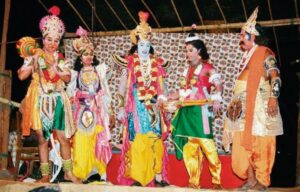
- Dashavatar: is the most developed theatre form of the Konkan and Goa regions. The performers personify the ten incarnations of Lord Vishnu-the god of preservation and creativity. The ten incarnations are Matsya (fish), Kurma (tortoise), Varaha (boar), Narsimha (lion-man), Vaman (dwarf), Parashuram, Rama, Krishna (or Balram), Buddha and Kalki. Apart from stylized make-up, the Dashavatar performers wear masks of wood and papier mache.
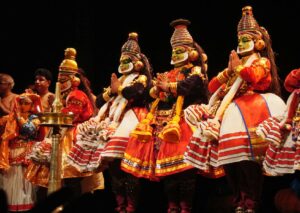
- Krishnattam: folk theatre of Kerala, came into existence in the middle of 17th century A.D. under the patronage of King Manavada of Calicut. Krishnattam is a cycle of eight plays performed for eight consecutive days. The plays are Avataram, Kaliamandana, Rasa krida, kamasavadha, Swayamvaram, Bana Yudham, Vivida Vadham, and Swargarohana. The episodes are based on the theme of Lord Krishna – his birth, childhood pranks and various deeds depicting victory of good over evil.
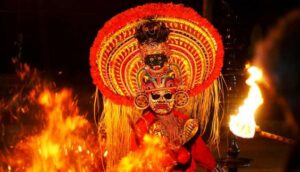
- Mudiyettu: traditional folk theatre form of Kerala is celebrated in the month of Vrischikam (November-December). It is usually performed only in the Kali temples of Kerala, as an oblation to the Goddess. It depicts the triumph of goddess Bhadrakali over the asura Darika. The seven characters in Mudiyettu-Shiva, Narada, Darika, Danavendra, Bhadrakali, Kooli and Koimbidar (Nandikeshvara) are all heavily made-up.

- Koodiyaattam: one of the oldest traditional theatre forms of Kerala, is based on Sanskrit theatre traditions. The characters of this theatre form are: Chakyaar or actor, Naambiyaar, the instrumentalists and Naangyaar, those taking on women’s roles. The Sutradhar or narrator and the Vidushak or jesters are the protagonists. It is the Vidushak alone who delivers the dialogues. Emphasis on hand gestures and eye movements makes this dance and theatre form unique.

- Yakshagaana: traditional theatre form of Karnataka, is based on mythological stories and Puranas. The most popular episodes are from the Mahabharata i.e. Draupadi swayamvar, Subhadra vivah, Abhimanyu vadh, Karna-Arjun yuddh and from Ramayana i.e. Raajyaabhishek, Lav-kush Yuddh, Baali-Sugreeva yuddha and Panchavati.
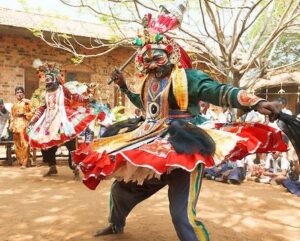
- Therukoothu: the most popular form of folk drama of Tamil Nadu, literally means “street play”. It is mostly performed at the time of annual temple festivals of Mariamman (Rain goddess) to achieve rich harvest. At the core of the extensive repertoire of Therukoothu there is a cycle of eight plays based on the life of Draupadi. Kattiakaran, the Sutradhara of the Therukoothu performance, gives the gist of the play to the audience and Komali entertains the audience with his buffoonery.














![]()






